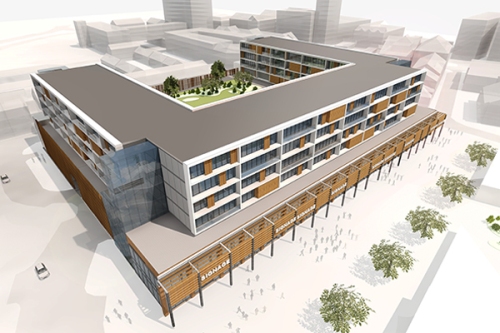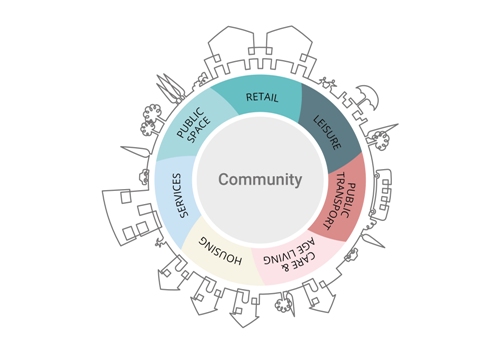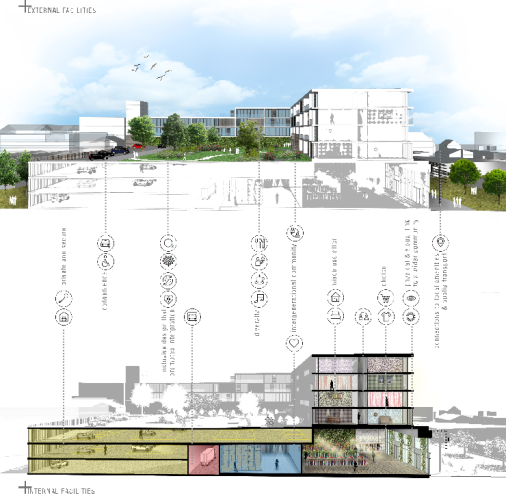Don’t ignore the “silver pound” – older people could save the high streets
With our ageing population, there is a surge in “younger - old” interested in a move to a home that better meets their lifestyle aspirations, including retirement living schemes. However, they also represent a huge, growing unsatisfied market. This is caused by the lack of variety that later life housing has to offer - schemes to answer the needs of an ageing population by providing HAPPI-influenced attractive, spacious and manageable housing in locations near local cultural and commercial amenities. We therefore need to reimagine the housing ‘offer’ to this aspirant cohort.
As an architect, I see at first hand that high quality, innovative design is crucial to attract people 65 age and over. And as covered by the Housing LIN in their Growing Older Together (opens new window) case study report, there is also considerable interest in co-housing and more community-led initiatives for older people and across the generations.
Looking at how we can design and plan more age-friendly homes and communities, I consider initiatives such as the Collective Old Oak (opens new window), which is a co-living housing scheme for young professionals in London, should also inspire the senior living sector. The same model can be applied to senior living schemes by offering communal lounge areas on each floor to bring people together, quiet rooms, dining experiences and roof garden for socialising. However, residents should also be able to access grocery stores, cafés, restaurants and gyms, all near their home. The offer of retail and leisure not only gives the convenience in senior living but also a chance to interact with someone.

When asked what would need within 500m from their house, most 65+ year olds agreed that any age-friendly accommodation will benefit from the following amenities within 500m from the site: a bus stop, a Doctors Surgery, a Bank and/or a Food Store. Indeed, for those looking for purpose-built housing or care, the EAC’s ‘locator’ provides useful information on individual schemes, including their location and access to local amenities.
Most purpose-built housing for older people tries to be integrated into the local community, with the ability to share facilities where practical to do so. However, as we age, the reality is that these quite often can feel or can be isolated from the outside world and excluded from the surrounding community or limited to the use of spa facilities, even if close to local amenities. Instead, older people must be treated as equal citizens with the opportunity to engage in the social and economic life of wider communities. They should be able to continue to lead an independent lifestyle, maintain and build new friendships, participate in community activities, and where they can easily access shops, restaurants, cafes and other forms of retail and leisure whenever they choose.

We should not forget that some people aged 65 and over have to or chose to continue working, necessitating them remaining actively involved in wider community life, close to transport, retail and other amenities. If senior living schemes are too isolated, these consumers will often stay in their existing homes or take up other housing that is more convenient to the way they currently live.
This need for mixed use developments with care, senior living, retail and leisure on offer are not only occupier driven. Urban and suburban retailers, through upgrading their offer in mixed-use schemes, can compete with large shopping destinations. Older residents can play an integral economic and social role in the wider national interest. They represent a new cohort of consumers – the “silver pound” - which is forecast to grow by 81% by 2030. At the same time, 69% of people aged 65 and over think that businesses have little interest in their consumer needs, even though it is clear that the older population can contribute both economically and to the retail sector.
With the extremely high land values in cities, the creation of mixed use developments not only answers the demands of modern living but also creates better funding opportunities. I believe mixed use schemes are key to the creation of a diverse and sustainable urban and suburban economy, providing activity, employment opportunities and vibrant public spaces.

The opportunity for the over 65 age group to contribute to the positive experience of life in the city and town centres, still engaged in leisure, retail and cultural pursuits, is something that should prove a crucial design driver for architects and urbanists over the coming decades. It is clear that people aged 65 and over still contribute to the economic and social prosperity of the country and their impact will be ignored at the industry’s peril.
"Don’t ignore the “silver pound” – older people could save the high streets"
All images supplied by UrbanEdge and are artist impressions

Comments
Posted on by Matt Miller
Older people can find living in or near town centres attractive. I would add restaurants, cafes, cinemas and theatres to your list above. We must also remember that older people usually have some level of choice about when or whether to move out of their current home. Therefore any move must be to something that is positively attractive, rather than for negative reasons (fear of crime, house hard to heat etc). Town centres can also be scary places associated with violence, noise late at night and drunk people vomiting in the street. So we are looking for the sweet spot where facilities are close enough to be accessible without car or taxi, but far enough away from the hubbub so residents can get some peace.
Also, the town centre still has to have enough facilities worth saving. If the retail offer amounts to places you can pawn your gold, unlock your mobile phone and buy 10 dusters for £1, it won't get people very excited.
Posted on by Mark Thomas
Love the "Age-friendly homes and communities" term. Can we now banish all the ones that focus on a number eg 65+ or the words 'old' and 'older' or 'retirement' or 'care village', and at the same time come up with a flexible planning classification that reflects the multiple benefits these developments deliver?
Add your comment